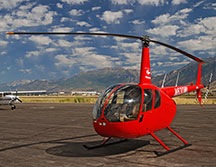I rediscover an old Christmas Present.
 A few years ago, my husband bought us a pair of Spin Master battery-operated radio-controlled helicopters. They’re tiny little things, maybe 8 inches long made of styrofoam, suitable for indoor flying only. We played with them that Christmas but soon lost interest with frustration. They’ve been lying around the house since then and I just charged them both up and started playing with mine again.
A few years ago, my husband bought us a pair of Spin Master battery-operated radio-controlled helicopters. They’re tiny little things, maybe 8 inches long made of styrofoam, suitable for indoor flying only. We played with them that Christmas but soon lost interest with frustration. They’ve been lying around the house since then and I just charged them both up and started playing with mine again.
 This isn’t my first RC helicopter. Back in the early 2000s — maybe 2002? — I bought a kit and constructed a gas-powered one. Mine was a Kyosho, probably a lot like this one. It was big — nearly 4 feet from the tip of the main rotor in front to the tip of the tail rotor in back. I painted it up to look a lot like my old R22 — white with a red stripe — which is what I was flying back then. The kit took hours to assemble and tune and, with the radio, I figure I sunk a little over $1,200 into it.
This isn’t my first RC helicopter. Back in the early 2000s — maybe 2002? — I bought a kit and constructed a gas-powered one. Mine was a Kyosho, probably a lot like this one. It was big — nearly 4 feet from the tip of the main rotor in front to the tip of the tail rotor in back. I painted it up to look a lot like my old R22 — white with a red stripe — which is what I was flying back then. The kit took hours to assemble and tune and, with the radio, I figure I sunk a little over $1,200 into it.
Soon afterward is when I realized I that flying an RC helicopter was a hell of a lot harder than flying the real thing.
Sure, I could fly a real helicopter. But an RC helicopter isn’t the same. Not only do you have to be able to lift off, hover, and fly — which requires putting your mind’s eye inside the aircraft — but you have to have it properly tuned and balanced first. Every time I tried to fly it, I crashed it. That usually meant destroying the main rotor blades, which cost about $55 to replace, and rebuilding. That meant rebalancing. And did I even have it balanced right in the first place?
I kept at it, though. I managed to learn how to hover it. That’s when I got cocky and tried to actually fly it. The resulting crash took out the main rotor blades, tail boom, tail rotor blades, and tail rotor gearbox. If it had been a real helicopter, my insurance company would have totaled it.
I rebuilt it with about $200 worth of parts and, along the way, made friends with another RC helicopter pilot. He helped me tune it properly. I joined him and his son at an RC field where his son flew my helicopter, partially to prove that it was airworthy. He did aerobatics with it. I’m talking about inverted flight, among other things. So it wasn’t the helicopter. It was the operator. It was me.
That was the last time I saw it fly.
In 2004, I sold it to a student pilot who happened to stop at Wickenburg Airport one day. I was running the FBO there at the time and he came with his flight instructor in for a break. The topic of RC helicopters came up. I told him I had one for sale and he bought it, on the spot, for $500 with a PayPal transfer. I gave him everything I’d accumulated for operations, including a toolbox with a few handy tools and a battery for getting the glow-plug going.
So a few years later, I wasn’t exactly happy to get a new RC helicopter as a Christmas gift. Sure, it was only about a $50 investment. But I was prepared for the frustration. That’s probably why it was cast aside so quickly.
(Honestly: I hate dumb gifts. I’d rather get nothing than something I don’t want or care about. I have enough crap around my house.)
 This year, however, RC helicopters are big. I’ve seen them in mall kiosks all over the place. They’re big electric models with fuselages designed to match real helicopters, both military and civilian. They seem to be a big hit.
This year, however, RC helicopters are big. I’ve seen them in mall kiosks all over the place. They’re big electric models with fuselages designed to match real helicopters, both military and civilian. They seem to be a big hit.
The main difference between these new RC helicopters and what I owned/own is that they use a stacked tandem rotor system with counter-rotating blades. As a result, there’s no issue with torque and no tail rotor is necessary. Because of this, I assume they’re a hell of a lot easier to fly. But they’re also kind of cheating, taking away the true helicopter flight experience — and the challenge.
I guess people don’t care about that. People want quick, easy thrills; they don’t want to actually put real effort into anything these days.
Even my little styrofoam RC helicopter has a tail rotor that actually works. As a result, it has the same basic aerodynamics as a real helicopter. Increase or decrease power and the nose shifts left or right accordingly. There’s a tail rotor trim toggle that has to be fine-tuned for flight. Since rediscovering the helicopter, I’ve spent most of my time just fine-tuning it so I can control it.
 On my little helicopter, forward movement is determined by simple weight and balance; a few push pins in the nose (see photo; sunglasses give you a sense of scale) gives me just the right amount of weight for slow forward flight. One control lever increases or decreases power, like a collective/throttle combination. Another lever points left or right like a limited action cyclic. Tail rotor trim can be avoided if set right. It’s pretty challenging and, fortunately, pretty sturdy. I crash-land almost every time I fly it, but I am getting better.
On my little helicopter, forward movement is determined by simple weight and balance; a few push pins in the nose (see photo; sunglasses give you a sense of scale) gives me just the right amount of weight for slow forward flight. One control lever increases or decreases power, like a collective/throttle combination. Another lever points left or right like a limited action cyclic. Tail rotor trim can be avoided if set right. It’s pretty challenging and, fortunately, pretty sturdy. I crash-land almost every time I fly it, but I am getting better.
I think it’s the RC helicopters I’ve seen in the mall that made me want to pull out my little RC helicopter and play with it again. I’d like to try (but not own) one of the new ones, just to see what it’s like. Until then, I’ll keep flying mine around the kitchen — at least until I finally snap the main rotor blades off.
 This year, they include “Snowballs.” This is a small spherical cookie made primarily of butter, flour, and finely chopped nuts, dusted with powdered sugar. Tasty without being too sweet.
This year, they include “Snowballs.” This is a small spherical cookie made primarily of butter, flour, and finely chopped nuts, dusted with powdered sugar. Tasty without being too sweet. Place balls about 2 inches apart on an ungreased cookie sheet. Because these don’t flatten out, you can get quite a few on a standard sized baking sheet or jelly roll pan. Although my first sheet had only a dozen (see photo), I was able to get two dozen on subsequent baking sheets.
Place balls about 2 inches apart on an ungreased cookie sheet. Because these don’t flatten out, you can get quite a few on a standard sized baking sheet or jelly roll pan. Although my first sheet had only a dozen (see photo), I was able to get two dozen on subsequent baking sheets. Bake for 8 to 10 minutes or until set but not brown. I judged that they were done when the tops began to crack ever so slightly.
Bake for 8 to 10 minutes or until set but not brown. I judged that they were done when the tops began to crack ever so slightly. Immediately remove from cookie sheet and roll in powdered sugar. Now although I tried this, I soon discovered that this was a very messy way to go about coating them with sugar. So instead, I put them on a wire rack with some newspaper (okay, it was Trade-a-Plane) under it and used a tea strainer to sift powdered sugar over them.
Immediately remove from cookie sheet and roll in powdered sugar. Now although I tried this, I soon discovered that this was a very messy way to go about coating them with sugar. So instead, I put them on a wire rack with some newspaper (okay, it was Trade-a-Plane) under it and used a tea strainer to sift powdered sugar over them.
 Place balls about 2 inches apart on an ungreased cookie sheet. Because these don’t flatten out, you can get quite a few on a standard sized baking sheet or jelly roll pan. Although my first sheet had only a dozen (see photo), I was able to get two dozen on subsequent baking sheets.
Place balls about 2 inches apart on an ungreased cookie sheet. Because these don’t flatten out, you can get quite a few on a standard sized baking sheet or jelly roll pan. Although my first sheet had only a dozen (see photo), I was able to get two dozen on subsequent baking sheets. Bake for 8 to 10 minutes or until set but not brown. I judged that they were done when the tops began to crack ever so slightly.
Bake for 8 to 10 minutes or until set but not brown. I judged that they were done when the tops began to crack ever so slightly. Immediately remove from cookie sheet and roll in powdered sugar. Now although I tried this, I soon discovered that this was a very messy way to go about coating them with sugar. So instead, I put them on a wire rack with some newspaper (okay, it was Trade-a-Plane) under it and used a tea strainer to sift powdered sugar over them.
Immediately remove from cookie sheet and roll in powdered sugar. Now although I tried this, I soon discovered that this was a very messy way to go about coating them with sugar. So instead, I put them on a wire rack with some newspaper (okay, it was Trade-a-Plane) under it and used a tea strainer to sift powdered sugar over them. A few years ago, my husband bought us a pair of Spin Master battery-operated radio-controlled helicopters. They’re tiny little things, maybe 8 inches long made of styrofoam, suitable for indoor flying only. We played with them that Christmas but soon lost interest with frustration. They’ve been lying around the house since then and I just charged them both up and started playing with mine again.
A few years ago, my husband bought us a pair of Spin Master battery-operated radio-controlled helicopters. They’re tiny little things, maybe 8 inches long made of styrofoam, suitable for indoor flying only. We played with them that Christmas but soon lost interest with frustration. They’ve been lying around the house since then and I just charged them both up and started playing with mine again. This isn’t my first RC helicopter. Back in the early 2000s — maybe 2002? — I bought a kit and constructed a gas-powered one. Mine was a
This isn’t my first RC helicopter. Back in the early 2000s — maybe 2002? — I bought a kit and constructed a gas-powered one. Mine was a  This year, however, RC helicopters are big. I’ve seen them in mall kiosks all over the place. They’re big electric models with fuselages designed to match real helicopters, both military and civilian. They seem to be a big hit.
This year, however, RC helicopters are big. I’ve seen them in mall kiosks all over the place. They’re big electric models with fuselages designed to match real helicopters, both military and civilian. They seem to be a big hit. On my little helicopter, forward movement is determined by simple weight and balance; a few push pins in the nose (see photo; sunglasses give you a sense of scale) gives me just the right amount of weight for slow forward flight. One control lever increases or decreases power, like a collective/throttle combination. Another lever points left or right like a limited action cyclic. Tail rotor trim can be avoided if set right. It’s pretty challenging and, fortunately, pretty sturdy. I crash-land almost every time I fly it, but I am getting better.
On my little helicopter, forward movement is determined by simple weight and balance; a few push pins in the nose (see photo; sunglasses give you a sense of scale) gives me just the right amount of weight for slow forward flight. One control lever increases or decreases power, like a collective/throttle combination. Another lever points left or right like a limited action cyclic. Tail rotor trim can be avoided if set right. It’s pretty challenging and, fortunately, pretty sturdy. I crash-land almost every time I fly it, but I am getting better.











 This is the second year in a row that I’ve created a calendar for my clients and other folks. It’s a typical 8.25 x 10.5 inch (folded) wall calendar. Open it and a full-page photo appears at the top with a calendar grid beneath it. The calendar includes U.S. Holidays (sorry, Canada), moon phases, and mini-calendars.
This is the second year in a row that I’ve created a calendar for my clients and other folks. It’s a typical 8.25 x 10.5 inch (folded) wall calendar. Open it and a full-page photo appears at the top with a calendar grid beneath it. The calendar includes U.S. Holidays (sorry, Canada), moon phases, and mini-calendars. The reason I had to finish today by noon is that MagCloud was running a 50% off sale. (Follow
The reason I had to finish today by noon is that MagCloud was running a 50% off sale. (Follow